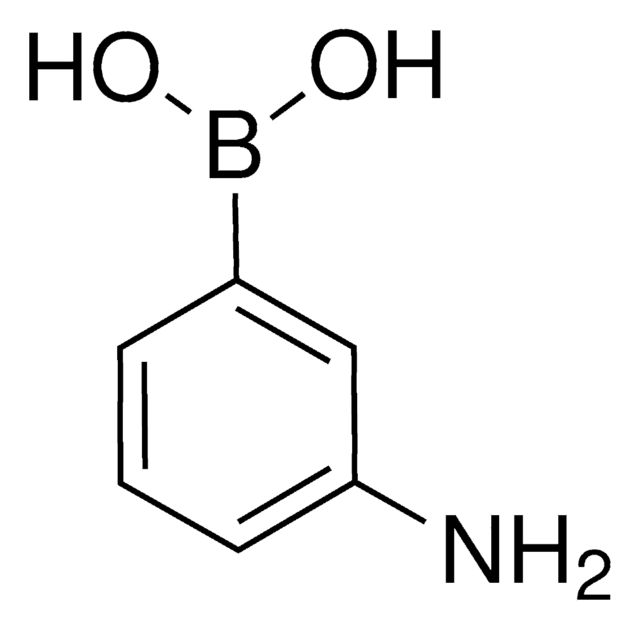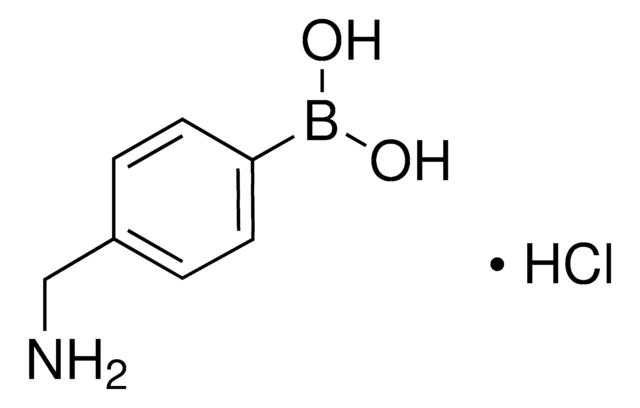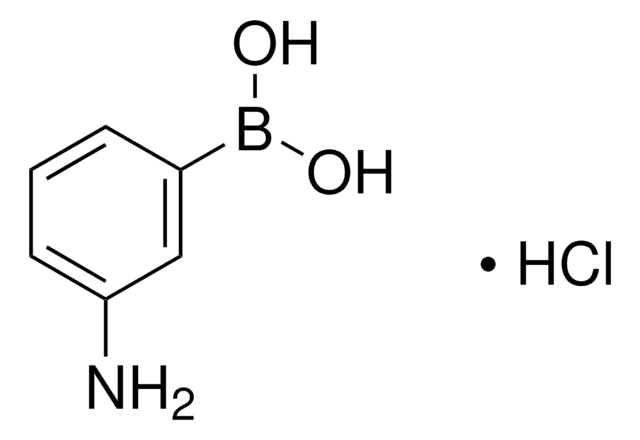Alle Fotos(2)
Wichtige Dokumente
912530
(4-((((2-Aminoethyl)carbamoyl)oxy)methyl)phenyl)boronic acid hydrochloride
≥95%
Synonym(e):
Amino boronic acid nuclear tag, Benzyl boronate tag, Nucleus-targeting probe building block
Anmeldenzur Ansicht organisationsspezifischer und vertraglich vereinbarter Preise
Alle Fotos(2)
About This Item
Empirische Formel (Hill-System):
C10H16BClN2O4
Molekulargewicht:
274.51
UNSPSC-Code:
12352106
Empfohlene Produkte
Assay
≥95%
Form
powder or crystals
Lagertemp.
2-8°C
Anwendung
(4-((((2-Aminoethyl)carbamoyl)oxy)methyl)phenyl)boronic acid hydrochloride is a benzyl boronic acid tag for the subcellular targeting of cargo to the nucleus. Intracellular targeting can be important for understanding the localization of metabolites, proteins, or chemical probes or to increase therapeutic efficacy by concentrating a drug at its site of action and reducing off-target effects. Localization specifically to the nucleus is typically achieved using peptide localization signals and/or relies on passive diffusion. It was recently demonstrated, however, that nuclear targeting could be accomplished instead with a small-molecule motif benzyl boronic acid via synergistic active and passive transport processes. Tang, et al, presented examples using this tag to deliver proteins to the nucleus by the importin α/β pathway, including fluorescent proteins, ribonuclease A (RNase A), and chymotrypsin. The conjugation of this nucleus-targeting building block to other proteins or small molecules will facilitate nuclear localization in varied chemical biology experiments.
Sonstige Hinweise
Ähnliches Produkt
Produkt-Nr.
Beschreibung
Preisangaben
Lagerklassenschlüssel
11 - Combustible Solids
WGK
WGK 3
Flammpunkt (°F)
Not applicable
Flammpunkt (°C)
Not applicable
Hier finden Sie alle aktuellen Versionen:
Analysenzertifikate (COA)
Lot/Batch Number
It looks like we've run into a problem, but you can still download Certificates of Analysis from our Dokumente section.
Wenn Sie Hilfe benötigen, wenden Sie sich bitte an Kundensupport
Besitzen Sie dieses Produkt bereits?
In der Dokumentenbibliothek finden Sie die Dokumentation zu den Produkten, die Sie kürzlich erworben haben.
Rui Tang et al.
Journal of the American Chemical Society, 139(25), 8547-8551 (2017-06-10)
Active intracellular transport is a central mechanism in cell biology, directed by a limited set of naturally occurring signaling peptides. Here, we report the first nonpeptide moiety that recruits intracellular transport machinery for nuclear targeting. Proteins synthetically modified with a
Unser Team von Wissenschaftlern verfügt über Erfahrung in allen Forschungsbereichen einschließlich Life Science, Materialwissenschaften, chemischer Synthese, Chromatographie, Analytik und vielen mehr..
Setzen Sie sich mit dem technischen Dienst in Verbindung.








